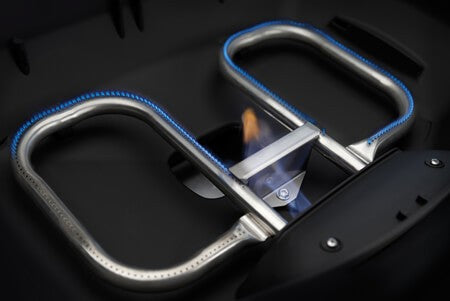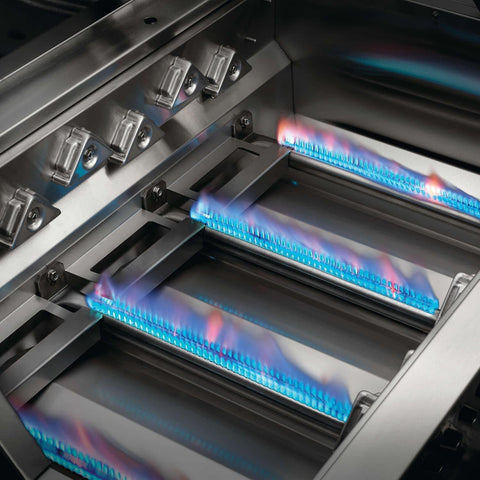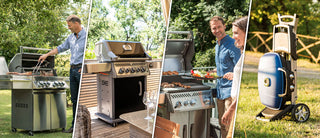Gas grills are becoming increasingly popular with grillers around the world. The reasons for this are many: they are easy to control and instantly provide the right temperature; they are easy to raise and lower; they heat up much faster; they do not have the odours and smoke of charcoal burning; they have a large surface area; and they can be used for both cooking and smoking food.
So when considering a gas grill, it is important to know where to start. We invite you to take a look at one indicator that is particularly important, and which we find that buyers pay very little attention to. And it is very important. Meet BTU.
BTU - what is it?
BTU is an English term British Thermal Unit abbreviation for British Thermal Unit. It is a rather old unit of measurement, dating back to the industrial boom. So it is not surprising that it is measured in a rather practical (and British) way:
1 BTU is the amount of heat needed to raise the temperature of 1 pound (453.92 g) of water by 1 degree Farenheit. We can also convert BTUs into the modern unit, the joule. 1 BTU = 1'055 J.
BTU is commonly used to measure the power output of heat generating, air-ventilating appliances and gas appliances. In this case, if the appliance (grill) has 20'00 BTU, it will generate that much power in 1h.
It is essential to measure the BTU of a grill as this is the most important indicator. The BTU number is the amount of heat your grill will generate with all burners on, operating at maximum capacity for 1 hour.
All manufacturers of gas grills that are even slightly more serious will be sure to include this figure in the parameters of the grill. And if it's not listed, there's a reason it's hidden.
However, even if BTU is listed, please note: some manufacturers are clever and, to make it look more impressive, they do not list the number of each burner, or they add up the BTUs of the burners inside the grill as well as the BTUs of the side cooker or the outside burners SIZZLE zone parameters. So reading more carefully is not only recommended, it's essential.

How many BTUs should I use?
Since the main cooking area of the grill is used for cooking, you will need to calculate how many BTUs are needed per 1 square cm of your grill grate area. Ideally, the BTUs per square centimetre of grill should be between 12.5 and 15.5.
Let's do the math:
NAPOLEON Rogue 525 gas grill has the following parameters:
BTU - 48'000; grill area - 73 x 45 cm (3'285 sq.cm).
This means that the BTU per 1 sq.cm. is:
48‘000 / 3‘285 = 14,61
The more BTUs the better?
Not quite true. The more BTUs your grill or individual grill burner has, the more gas it will consume when it is operating at maximum. Powerful burners are good, of course, especially when you want a perfectly seared steak or pizza. But after all, you're only likely to cook them in a certain area, not in the whole (especially large) grill.
So our recommendation is to only choose gas grills where the burners can be switched on and off independently of each other. Cheap gas grills usually have a combustion system spread over the whole area and it is not possible to switch only part of it on (which adds to the cost). In this case, although you save money when you buy the grill, there is no saving when you cook - you are just burning gas unnecessarily...

For this reason, NAPOLEON, one of the largest grill companies, was the first to offer a solution that has become very popular and has already been copied by others - SIZZLE ZONE (). This is a separate, small zone on the side of the grill that heats up very quickly. The NAPOLEON sizzle zone can reach up to 800 degrees of heat! Grilling steaks, barbecues or other dishes that require hot temperatures here is not only much more efficient, but also quicker and more comfortable. Special patented technology allows you to achieve ultra-high temperatures at minimal cost.
Grill volume and weight - why does it matter?
BTUs are not all that determines your grill's gas consumption and ability to reach high temperatures. Other aspects are just as important to consider.
The high internal ttion means that the burners create BTUs will have to heat all the air barbecues inside the grill and the metal the interior components, the bottom, sides and lid of the grill. So geros gas grills available at made of heavier, thicker, more durable materials and parts that will retain heat. There is a reason why manufacturers emphasise thick or double grill lids, sturdy construction, metal thickness or materials.
Here, for example, is NAPOLEON PRO™ 500 gas grill available at an aluminium base and a large capacity. Thanks to the well-designed air flow movement and the reflection of heat into the aluminium it will heat up quite quicklyand the heat generated will remain inside.

Even a part of the grill such as the grill grates will certainly contribute to heat storage. Thick stainless steel or cast iron grates will retain heat much longer than thin metal ones.
So when choosing a gas grill, looking at its weight is a very logical and correct decision.
Controlled air flow - what are we talking about?
Airflow movement is an important aspect of any grill. It affects optimal combustion. Properly constructed gas grills have openings that allow the airflow to move from the bottom to the top and to exit at specially designated points.
Think about how your fireplace chimney workss. You may have grill with all the BTUs in the world, but if good airflow is not created inside the grill, your grill will not cook efficiently and will not be powerful.
It is equally important that the air inlet and outlet cavities are very carefully designed. They must allow the oxygen needed for gas combustion to enter and they must allow it to exit, but in such a way that the grill is not over-cooled, as much heat as possible is retained inside and a stable temperature is maintained.
You may also notice that the grill grates are hotesnių and coldavailable at places - this is very often observed when cooking with cheaper grills. Nevertheless, even the world's best gas grills can have airflow problems if the weather is extremely windy - and the same goes for all types of grills in general.
Another reason why a well-designed cavity is important is the quality of the food you grill. If the fuel in the grill does not burn completely, it will not get enough oxygen, the gases will not burn cleanly and the by-products of combustion will remain on your food. This is bad for both you and the environment. Such grills may not even produce a stable temperature or have enough power.



